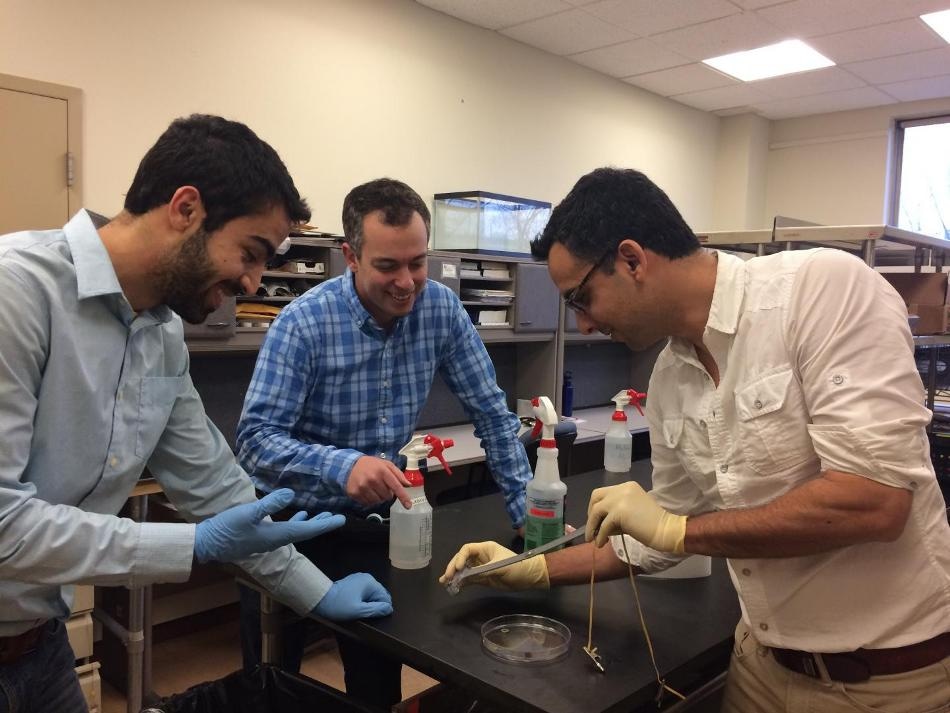Feb 14 2017
 Navid Kazem (left), Jonathan Malen (center), and Carmel Majidi (right) demonstrate the elasticity of a strip of 'thubber,' a thermally conductive rubber material that represents a breakthrough for creating soft, stretchable machines and electronics. Navid is a Ph.D. student and Malen/Majidi are associate professors of mechanical engineering at Carnegie Mellon University Credit: Lisa Kulick
Navid Kazem (left), Jonathan Malen (center), and Carmel Majidi (right) demonstrate the elasticity of a strip of 'thubber,' a thermally conductive rubber material that represents a breakthrough for creating soft, stretchable machines and electronics. Navid is a Ph.D. student and Malen/Majidi are associate professors of mechanical engineering at Carnegie Mellon University Credit: Lisa Kulick
A thermally conductive rubber material representing a breakthrough for developing stretchable, soft electronics and machines has been developed by Carmel Majidi and Jonathan Malen of Carnegie Mellon University.
This week’s issue of Proceedings of the National Academy of Sciences has published the findings.
This new rubber material, nicknamed “thubber,” is considered to be an electrically insulating composite that is capable of exhibiting an exceptional combination of metal-like thermal conductivity and elasticity very much like a soft, biological tissue that has the potential to stretch more than six times its initial length.
Our combination of high thermal conductivity and elasticity is especially critical for rapid heat dissipation in applications such as wearable computing and soft robotics, which require mechanical compliance and stretchable functionality.
Carmel Majidi, Associate Professor of Mechanical Engineering, Carnegie Mellon University
“Thubber” can be used in industries such as sports medicine and athletic wear - imagine the use of heated garments for injury therapy and lighted clothing for runners. The stretchable electronic material could also create an impact in improved areas such as transportation, energy and manufacturing to name a few.
Until now, high power devices have had to be affixed to rigid, inflexible mounts that were the only technology able to dissipate heat efficiently. Now, we can create stretchable mounts for LED lights or computer processors that enable high performance without overheating in applications that demand flexibility, such as light-up fabrics and iPads that fold into your wallet.
Carmel Majidi, Associate Professor of Mechanical Engineering, Carnegie Mellon University
A suspension of non-toxic, liquid metal microdroplets is considered to be a vital ingredient in “thubber”. The liquid state enables the materials to deform with the surrounding rubber at room temperature. The droplets produce elongated pathways vital for heat travel when the rubber is pre-stretched. The material also seems to be electrically insulating despite the amount of metal.
The team demonstrated these findings by mounting an LED light onto a strip of the material in order to develop a safety lamp worn around a jogger’s leg. The heat from the LED was dissipated by the “thubber”, which would have otherwise resulted in burning the jogger. A soft robotic fish swimming with a “thubber” tail was also developed by the team without using standard gears or motors.
As the field of flexible electronics grows, there will be a greater need for materials like ours. We can also see it used for artificial muscles that power bio-inspired robots.
Carmel Majidi, Associate Professor of Mechanical Engineering, Carnegie Mellon University
Majidi and Malen acknowledge the efforts of key authors Michael Bartlett, Navid Kazem, and Matthew Powell-Palm in executing this multidisciplinary work. They also acknowledge funding from the Army Research Office, NASA, and the Air Force.